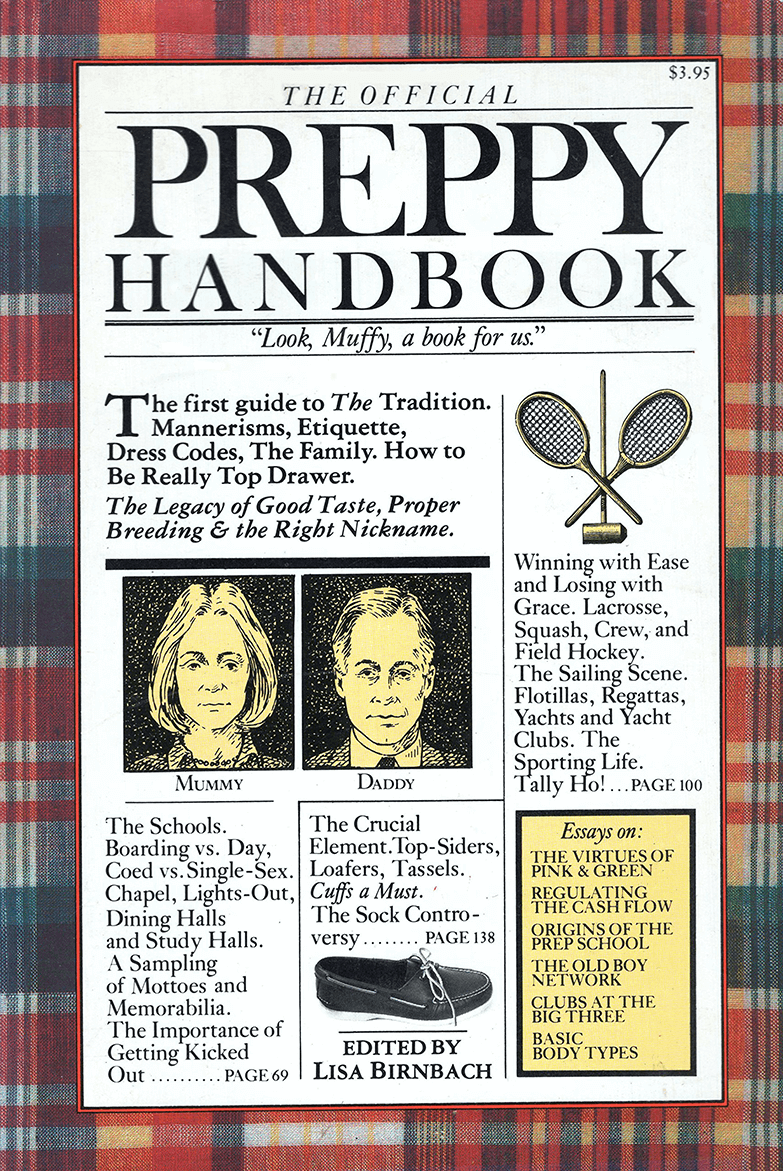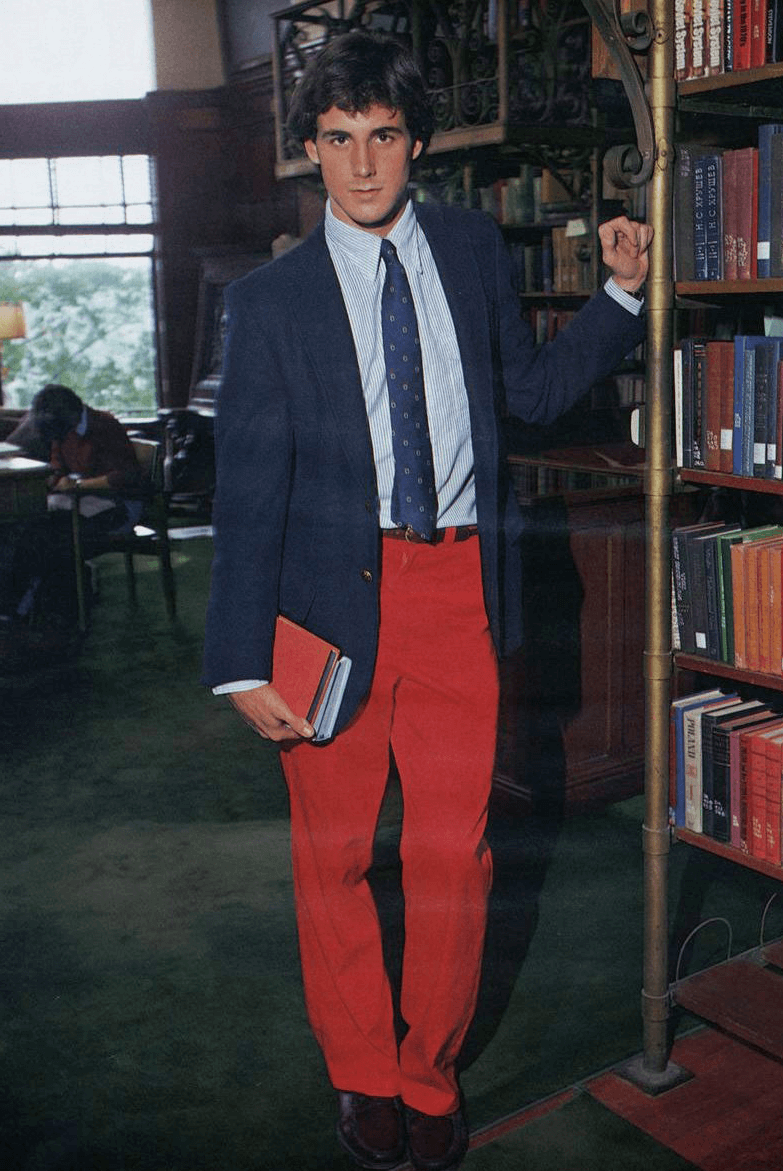Preppy fashion hasn’t gone out of style in the best part of a century. Combining tailored pieces and sportswear, it’s clothing made for recreation and is arguably where smart-casual menswear began.
It’s also one of the most influential movements in the history of men’s style. It began on the campuses on Ivy League universities in the US, but preppy clothing brands didn’t stay there long.
Labels like Ralph Lauren and Tommy Hilfiger made preppy the unofficial dress code for smart-casual America. It’s also been co-opted by other style tribes like hip-hop and skatewear, while international influences mean you’ll find excellent preppy brands not just in the US but in the UK, Japan, France and Italy, too.
Today, preppy is a broad church. To help you find your way around, we’ve listed the best preppy clothing brands, from classic Ivy League outfitters to modern labels that have remixed the classics in interesting new ways.
Brooks Brothers

No one can deny Brooks Brothers is an American icon. Founded in 1818 in New York by Henry Sands Brooks, it introduced its first ready-to-wear suits way back in 1849. To give this come context, 1818 was the year the White House officially reopened after being burned in 1814 by the British in the War of 1812. Brooks Brothers have provided preppy clothing for the American elite (and beyond) ever since.
Favoured at the highest level by many a US president, including most famously JFK, the brand is noted for its high-quality, timeless clothing. A true American institution.
Shop now at Brooks Brothers
J.Crew


American brand J.Crew was founded in 1947 by Mitchell Cinader and Saul Charles and today operates around 450 stores in the US. Its focus is style over fashion, but with a distinctive preppy edge. In it’s campaign and lookbook shots you’ll find modern pairings of sneakers with suits and brogues with jeans, alongside traditional colour-blocking and pattern mixing. The quality is good, and the price point reasonable.
Shop now at J.Crew
Ralph Lauren


American designer Ralph Lauren (born Ralph Lifshitz) founded the Polo Ralph Lauren Corporation in 1967. It was 1977, 10 years after the company was founded, when it introduced the signature cotton mesh Polo shirt in various colours. Featuring the now-iconic polo player logo on the chest, the shirt became emblematic of the preppy look, and put Ralph Lauren on the map. Lauren himself breathed the American Dream into a clothing (and more) brand – creating the embodiment of a particular lifestyle or way of life.
Shop now at MATCHESFASHION
Billy Reid


Southern preppy is a niche style tribe that sits in the broader Americana family – it takes classic preppy fashion but gives it a slightly looser, more casual, ranch-ready flavour. Billy Reid is its patriarch, a designer who’s highly revered in fashion circles even if he doesn’t have the mainstream clout of a Lauren or Hilfiger.
Everything you expect from the best preppy brands is here, especially polo shirts, button-downs and easy-wearing shorts and trousers.
Shop now at Billy Reid
Aurelien


The quiet luxury movement borrows heavily from some of the understated, but always sophisticated, style of preppy fashion. Aurelien puts an Italian spin on it, with timeless garments like knitted polos, loafers and unstructured tailoring.
It’s a direct-to-consumer label, meaning it offers lower prices than some of the designer labels it shares factories and mills with.
Shop now at Aurelien
Luca Faloni


Italian menswear has long remixed the staples of preppy fashion with a touch of La dolche vita. Think knitted polo shirts, unstructured blazers, tailored chinos.
Luca Faloni does all of these and more, at prices lower than you’d expect for a label that’s 100% made in Italy. The vibe is definitely more tailored and summery than classic collegiate style but the brand also weaves in hoodies and sweats – again given a luxe touch in beautiful knitted fabrics.
Shop now at Luca Faloni
Pelota Sporting Clothiers


British brand Pelota designs clothes for ‘Aprés Sport’: that period of time where a sportsman’s endeavours ends and social life begins. Inspired by some of the world’s finest ball sports – the type of games that were so prevalent on Ivy League campuses in the 50s – expect high-quality hoodies, sweats and tees in an athletic yet forgiving fit. The definition of athleisure.
Shop now at Pelota
Jack Wills


Jack Wills was founded by Peter Williams and Robert Shaw in 1999. The brand’s original store opened at 22 Fore Street, Salcombe and was created to, “bottle what being at a British university was all about”. Today Jack Wills combines heritage style with a youthful, irreverent and carefree edge. The label quickly went mainstream in the 2000s and was viewed as UK’s answer to Abercrombie & Fitch.
Shop now at Jack Wills
Abercrombie & Fitch


With a long and rich heritage, Abercrombie & Fitch was founded in 1892 in New York by its namesakes, David T. Abercrombie and Ezra Fitch, developing a reputation as an elite outfitter of sporting and outdoor goods. Now it’s more known for its racy marketing photography featuring semi-nude males and females, often employees of its stores.
A&F’s signature moose logo was once the “badge” to be seen in, but its pull has since waned. However, with a change in tack in recent years the brand has refocused on what helped made its name in the fist place: high-quality preppy basics that epitomise that laid-back California lifestyle.
Shop now at Abercrombie & Fitch
Tommy Hilfiger


Founded by Thomas Jacob “Tommy” Hilfiger in 1985, the brand is known for its classic Americana style with a preppy twist. Hilfiger is still the brand’s principal designer despite having sold the company back in 2006 for $1.6bn. While the label has suffered in recent years, since 2017 it has experienced a renaissance thanks to the revival of 1990s menswear.
Shop now at FarFetch
GANT


GANT was founded in 1949 by Bernard Gantmacher as a shirtmaking company in the college town of New Haven, Connecticut. It quickly became known for its Oxford shirts, which featured the perfect collar roll, a locker loop, box pleat, back collar button and button tab. Located near to Yale University, the US label played a major role in shaping the Ivy League Look as we know it today.
Shop now at John Lewis
Hackett


Hackett was founded in 1979 by Jeremy Hackett and Ashley Lloyd-Jennings from a stall on London’s Portobello Road selling used clothes. Despite its humble beginnings, Hackett has gone on to become a stalwart of the new breed of fine British brands. Today, you’ll find a wide-spanning range that runs the gamut from high-quality basics right through to bespoke tailoring.
Shop now at FarFetch
Drake’s


Founded by Michael Drake in 1977 in London’s East End, Drake’s quickly earned a reputation for producing quality scarves and shawls for high-end fashion boutiques and traditional tailoring houses. This initial success saw the company branch out into ties and pocket squares for which the brand is recognised for.
A philosophy of producing timeless pieces that have a relaxed elegance, to exacting standards, ran through Michael’s and the brand’s veins. A recipe for success in itself, Drake’s soon became a firm favourite of style tastemakers here in the UK, but never by the mainstream – intentionally no doubt.
Shop now at Drake’s
G.H.Bass


G.H. Bass & Co. dates back to Maine in 1876 when the footwear company was founded by George Henry Bass. But it wasn’t until 1936 – when G.H. Bass put a stylish spin on a Norwegian farm shoe designed for “loafing in the field”, dubbing them “Weejuns” – that the brand went mainstream and history was made.
Known for creating the world’s first penny loafer, the company have never looked back. Arguably the defining preppy shoe, the iconic Weejun has been a firm favourite of everyone from Ivy League graduates to the late Michael Jackson ever since.
Shop now at MR PORTER
Sperry


Sperry is the original American brand of boat shoe, first designed in 1935 by Paul A. Sperry. Rumour has it that while sailing on the Long Island Sound, Sperry slipped on the deck of his boat and fell overboard – an experience which drove him to develop a safer, non-slip shoe. Multipurpose, the Sperry Top-Sider Deck (or boat) shoe has been seen on a variety of celebrities and presidents including, again, JFK.
Shop now at END.
Beams Plus


It’s an oft-repeated opinion in menswear circles that Japanese fashion didn’t just adopt preppy Americana – it perfected it. The classic Ivy League look of the 1960s was lifted wholesale by Japanese prepsters and brands alike, who then began crafting their own versions of preppy fashion.
Beams Plus is one of the most beloved and enduring labels to do it. Part of a huge retail empire that stretches back to the 70s, it combines heritage menswear and rugged workwear to create its own take on so-called “Ametora” or Japanese Ivy. Think well-made garments with generous cuts and nerdy details.
Shop now at MR PORTER
LL Bean


Founded in New England, the spiritual home of preppy fashion, LL Bean is one of the most historic and influential Americana brands, renowned for its hardy, well-made outdoor gear. It’s more rugged than some preppy labels, but the collection is also vast: you’ll find smarter chinos and Oxford shirts among the camping gear and workwear.
The label does a lot of classics, but start with its chamois shirts, logo tees and quarter-zip tops.
Shop now at LL Bean
Lacoste


Preppy fashion has always been a combination of dapper menswear and classic sportswear. In that sense, Lacoste is one of the quintessential preppy brands, its famous crocodile-emblazoned polo shirt the creation of French tennis maestro Rene Lacoste. He wore the shirt on court and quickly realised it looked great off-court too. The rest is history.
The brand isn’t all about the polo, however. You’ll also find other preppy classics in its collections, from knitted V-necks and sweatshirts to zip-up track tops.
Shop now at END.
Crew Clothing


Many of the best preppy labels have their roots in sport and recreation, and Crew Clothing is no different. Inspired by the British coast it started life behind a windsurfing shop, and much of its collection is built for life on or near the water.
Deck shoes, raincoats and beachwear are all present and correct, but it also does a good line in heritage British menswear, from stout rugby jerseys to rowing blazers. It’s also one of the most affordable preppy brands you’ll find.
Shop now at Crew Clothing
Noah


Preppy fashion is so influential that it went from 60s college students to 80s finance bros to 90s skate kids. The latter inspired ex-Supreme creative director Brendon Babenzien to found Noah, a New York label which lovingly recaptures the fusion between skatewear and preppy fashion.
There’s a heavy dose of JFK-lite nautical style, plus slacks and loafers, but it’s mixed with big graphic tees and eye-popping prints. Somehow, it just works and it’s all very, very easy to wear.
Shop now at Noah
Ivy Ellis


Good preppy style is all about the little details, a fact not lost on Scottish brand Ivy Ellis. It does socks, mainly. Excellent preppy socks. Think throwback athletic styles from the 70s or 80s and woollen slub styles, both of which borrow from varsity colours and look great with shorts and slacks alike.
Everything is made in Scotland and you’ll feel the quality as soon as you pull them on.
Shop now at Ivy Ellis
Vineyard Vines


Born in Martha’s Vineyard, one of those New England enclaves where America’s well-to-do spend their summers, Vineyard Vines was born in the 90s but it’s a faithful and loving take on classic preppy style.
It does all the essentials, and does them well: polos, ribbed sweaters, button-down shirts, slacks, shorts and casual tailoring. You won’t find many preppy brands more authentic than this one.
Shop now at Vineyard Vines
Armor-Lux


Classic French outfitter Armor-Lux has been making distinguished, nautical-themed fashion since the 1930s. It’s best-known for its near-peerless Breton tops, but other preppy must-haves include sailing-style raincoats, polo shirts, blazers and fisherman jumpers.
With its collections still designed and made in Brittany, Armor-Lux brings a sophisticated, Gallic interpretation of preppy style.
Shop now at END.
Aime Leon Dore


With its lookbooks set in wood-panelled dorm rooms, cult New York label Aime Leon Dore wears its preppy influences proudly. The brand is one of a handful to have taken Ivy League style somewhere new in recent years.
You’ll find classic sportswear and more tailored preppy pieces like tweed jackets in the collection, but it’s all mixed up with hip-hop references and streetwear. If it sounds eclectic, that’s absolutely the aim, but the overall effect is modern, urban and classic all at once.
Shop now at Aime Leon Dore
The History Of Preppy Style
At first glance, preppy may seem like a fashion disaster. After all, few style clans can team washed-out red trousers with a green polo shirt, mix pink with purple, yellow with honeydew, set a bold stripe next to a Madras plaid, and live to tell the tale. Even fewer would actually want to.
This was the preppy of Lisa Birnbach’s defining and cheekily undercutting Official Preppy Handbook, 1980’s seminal homage to the life of Anglophile East Coast gentrification – the monied, relaxed and subtly style-aware existence of messing about on the Hamptons’ tennis and croquet courts, with horses, yachts and clubs (both golf and country), bow-haired girl in the one hand, G&T firmly in the other. Preppy is a label that has stuck. Florida’s Koch Crime Institute once identified a criminal youth clan – comprising upper-middle-class, high-income, socially-active members – as “preppy gangs”.
- Lisa Birnbach’s ‘Official Preppy Handbook’
- Red chino trousers – taking Preppy to the extreme
But there is more to the preppy uniform than a love of colour mixing. Its 1980s incarnation was the style of discreet wealth for young American East Coasters, though preppy became established as benchmark in menswear through US pop culture. More positively, Hollywood late 1970s/early 1980s “frat pack” movies such as Animal House, The Sure Thing and St Elmo’s Fire saw white-toothed and casually thrown together Rob Lowe clones – who looked rather good for it.
Music had preppy dabbler Michael Jackson, all white socks and loafers, as well as the Beastie Boys and any number of upscale B-Boy skate bands to look to – their version was more one of an appropriation of the rich man’s playthings as social commentary, undermining the symbols of wealth with irony and faux club crests, but it has also given the look longevity.
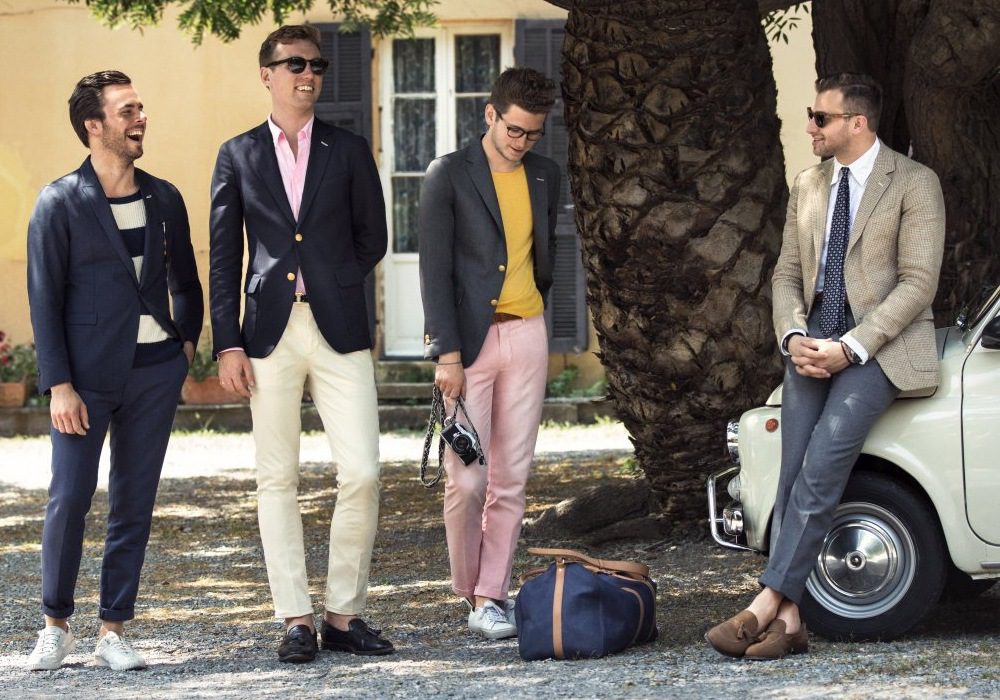

Modern day preppy by GANT Rugger
Yes, Birnbach appreciated that preppy had its limitations: loaded with connotations of class and wealth, and even too restricted by age limits. Forty was, she determined, the age when you could finally wear your polo shirt collar turned down. Additionally, here men face an additional problem: preppy may speak style in the US language of cool, but in the UK it says “Sloane” – to anyone beyond Chelsea the sartorial kiss of death. So, to be sure, you have to look further back to get it safely right. And, certainly, preppy goes back much further than many are aware – such that it allowed US designers the likes of Tommy Hilfiger and Ralph Lauren to build empires around it.
This is the preppy of the 1950s and 1960s – the preppy that brought together ex-US forces khakis and Brooks Brothers or Gant Oxford shirts, saddle shoes and sweatshirts, Bass Weejun loafers and regimental ties, shawl-collar cardigans, hopsack blazers and slimline European suits, worn white pumps and plain white T-shirts. This is the preppy that then put together what in isolation can seem rather pedestrian clothing – the clothes of an older generation even – in such a way as to look just… right. This is the preppy that inspired the Italians that then inspired the mods, that lent elements of its dress sense to ska and skinhead.
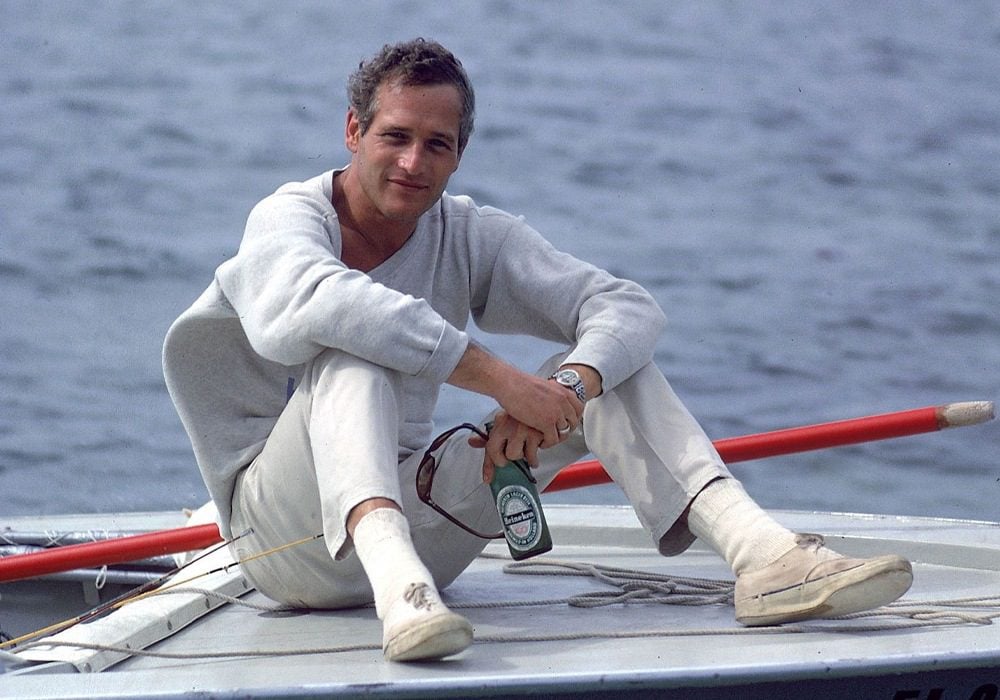

Paul Newman was a preppy style icon
Indeed, this is the preppy that’s arguably the single most influential look in 20th century menswear, born of the attire of the US’s elite Ivy League students and their demand for practical, hard-wearing but always at least elegant attire (the definition of smart casual). This is the preppy of Paul Newman, JFK and Miles Davis. Wear preppy and, while you may not be the height of fashion, you cannot go wrong.
“Prep is rooted is all about confidence, eclectic details and not taking yourself too seriously. Prep can be classic, laid-back, or even rock ‘n’ roll. But it always works.” – Tommy Hilfiger
Davis was a case in point. Contrary to his culture and his race – preppy was originally both very monied and very white – Davis was a regular of Charlie Davidson’s The Andover Shop in Cambridge, Massachusetts, the store where Ivy League style took hold. Miles’ preppy was a look that helped define “jazz cool”, but also helped win what was then still an avant garde form of music a new acceptability.
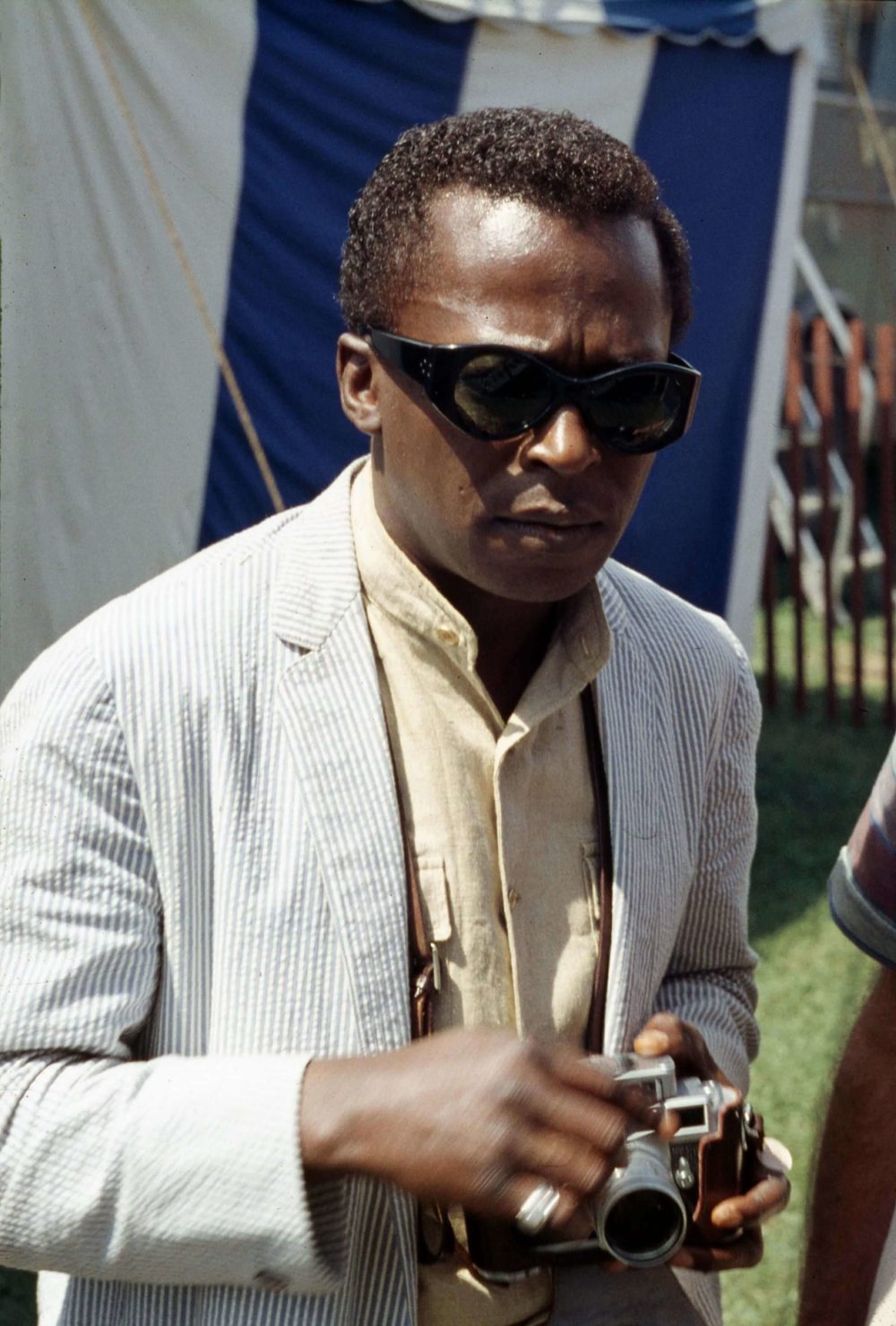

Miles Davis wearing seersucker
But “The Warlord of the Weejuns”, as critic George Frazier would dub Davis on the liner notes for a greatest hits collection in 1965, proved too that you could wear preppy in your own way. Davis would wear drop-shoulder seersucker sports jackets – they were easier to play trumpet in – without cuff-buttons or a breast pocket, or formal, double-breasted suits with more casual patch pockets; a knotted neckerchief under the button-down collar of his shirts, often with an unusual pullover placket.
Yet might Kennedy have even owed his presidency to preppy? It’s been suggested at least that the way this Ivy-Leaguer dressed was in part what helped set him apart from previous generations of dowdy politicians, that made him strike the populace as youthful and dynamic. Such was to become JFK’s influence that British boys of the time were said to have requested their hair styled into Kennedy’s trademark tousled thatch, carefully contrived to look unruly – a touch of artful dishevelment being part of the preppy code.
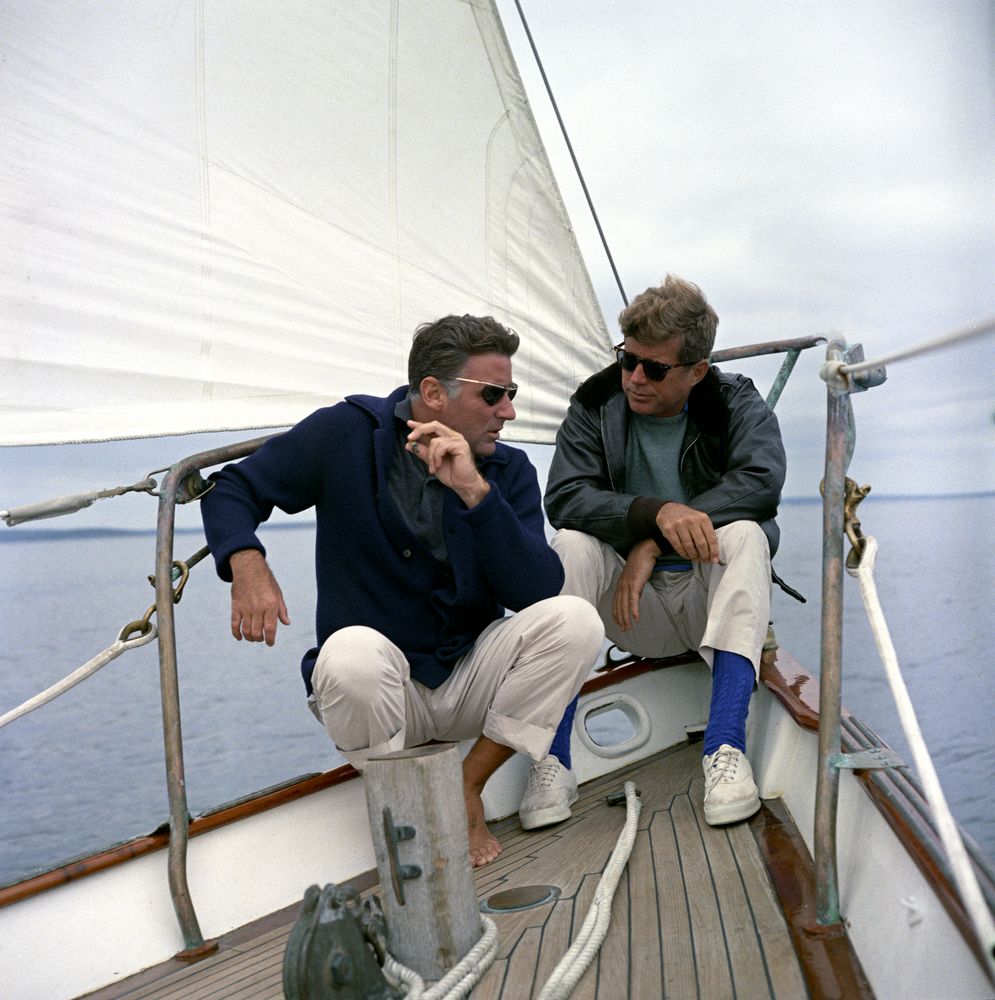

President John F. Kennedy and Peter Lawford Aboard the Yacht “Manitou”, 12 August 1962. Credit: Robert Knudsen. White House Photographs. John F. Kennedy Presidential Library and Museum, Boston
One desperate hatmaker wrote to Kennedy pleading to him to wear a hat – JFK had a notorious dislike of hat-wearing: “You have set a new pattern for youth,” he told Kennedy. “What may be a personal attitude for you is becoming a must for these young hatless people…” The popularity of button-down shirts and dark suits all changed according to Kennedy’s unofficial endorsement. Arguably preppy has never lost the agelessness that Kennedy gave it.
Indeed, his – as was the case for the first wave of preppy – was essentially a minimalistic, classic style. Certainly it was a long, long way from the second wave of the 1980s, with its love of excessive, look-at-me colour and pattern. Really, it’s a shame the two have ever been confused. One trusts that, after reading this, the reader feels somewhat put straight. And is ready to look to an aesthetic more than half a century old for some lifelong style tips.

